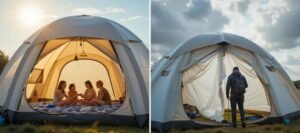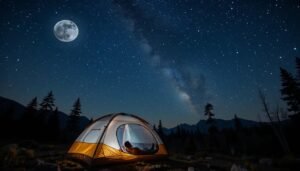Introduction
Camping in extreme weather conditions requires more than just the right mindset—it demands the most durable and well-designed tents capable of withstanding the harshest elements. Whether you’re facing strong winds, heavy rain, or deep snow, having a reliable, weather-resistant tent can mean the difference between a safe, comfortable trip and a miserable, dangerous experience.
In this guide, we will explore:
- What makes a tent truly durable?
- Key features to look for in weather-resistant tents.
- The best tents tested for wind, rain, and snow in 2025.
- Tips on how to maximize your tent’s durability.
From high-altitude expeditions to stormy coastal adventures, this article will help you find the best tent for any environment.
1. What Makes a Tent Durable?
Not all tents are built to withstand extreme weather. When looking for a tent that will hold up against strong winds, rain, and snow, consider the following essential factors:
A. Tent Fabric and Material
- Ripstop Nylon or Polyester: These synthetic materials provide excellent resistance to tears, abrasions, and water infiltration.
- Canvas (Cotton Tents): Heavier but extremely durable, ideal for long-term camping in wet or snowy conditions.
- Silnylon and Dyneema: Lightweight but incredibly strong materials, often used in high-performance expedition tents.
B. Pole Structure and Frame Strength
- Aluminum Poles: Stronger and more flexible than fiberglass, providing better wind resistance.
- Geodesic and Dome Designs: Offer superior wind stability compared to basic A-frame or cabin tents.
- Double or Crossed Poles: Improve overall tent rigidity and weight distribution, crucial for heavy snow loads.
C. Waterproofing and Seam Sealing
- Hydrostatic Head Ratings: Look for at least 3000mm+ for rainproof performance.
- Sealed or Taped Seams: Prevent water from seeping into the tent during heavy rain.
- Bathtub-Style Floors: Elevated floor edges keep water from pooling inside the tent.
D. Ventilation and Condensation Control
- Multiple Air Vents: Reduce condensation buildup, preventing internal dampness.
- Mesh Panels with Covers: Allow airflow while keeping wind-driven rain and snow out.
These factors define a truly weatherproof tent that can handle extreme conditions.
2. The Best Tents for Wind Resistance
A. Key Features for Windproof Tents
- Aerodynamic Shape: Dome and tunnel tents offer less resistance to wind compared to flat-walled designs.
- Low Profile: Shorter tents present a smaller surface area for wind to push against.
- Secure Anchoring System: Strong guy lines, reinforced stake loops, and extra attachment points help prevent the tent from collapsing.
B. Best Tents for High Winds in 2025
| Tent Model | Wind Resistance Rating | Key Features |
|---|---|---|
| Hilleberg Nammatj 2 | Up to 80 mph winds | Tunnel shape, reinforced poles, 4-season rating |
| MSR Remote 2 | Tested in extreme wind conditions | Geodesic design, strong DAC poles, good ventilation |
| Black Diamond Eldorado | Expedition-grade stability | Single-wall, reinforced seams, low-profile |
All these models have been tested in real-world storm conditions, proving their ability to withstand extreme wind.
3. The Best Tents for Heavy Rain
A. What Makes a Tent Rainproof?
- High Hydrostatic Head Rating: A waterproof rating of 3000mm or higher is ideal.
- Full-Coverage Rainfly: Provides complete protection from rain and wind-driven moisture.
- Bathtub Floor Construction: Prevents water from seeping in through the ground.
B. Best Waterproof Tents in 2025
| Tent Model | Waterproof Rating (mm) | Key Features |
|---|---|---|
| Big Agnes Copper Spur HV UL2 | 5000mm+ rainfly & floor | Lightweight, fully taped seams, excellent ventilation |
| The North Face VE 25 | 6000mm rainfly, 10000mm floor | Expedition-grade protection, triple-layered rainfly |
| Zpacks Duplex Tent | Fully Dyneema-fabric waterproofing | Ultralight but highly resistant to heavy rain |
C. Pro Tips for Staying Dry
- Always set up on higher ground to prevent pooling.
- Use a footprint or groundsheet to protect the bottom of the tent.
- Keep gear inside waterproof dry bags for added protection.
4. The Best Tents for Snow and Cold Weather
A. Key Features for Winter Tents
- Double-Wall Design: Reduces condensation and improves heat retention.
- Strong Pole Structure: Can support the weight of heavy snowfall.
- Extended Vestibules: Allow space to store wet gear outside the sleeping area.
B. Best Cold-Weather Tents in 2025
| Tent Model | Cold Weather Performance | Key Features |
|---|---|---|
| Mountain Hardwear Trango 2 | Excellent for sub-zero temps | 4-season rated, strong frame, reinforced seams |
| MSR Access 3 | Designed for snowy conditions | Lightweight yet strong enough for winter use |
| Hilleberg Jannu | Extreme alpine durability | Highly windproof, insulated inner tent |
C. Pro Tips for Winter Camping
- Clear snow before setting up to prevent sinking.
- Use insulated sleeping pads to block cold from the ground.
- Keep vents open slightly to reduce condensation buildup.
5. How to Increase Your Tent’s Longevity in Harsh Weather
A. Proper Setup Techniques
- Stake Down and Guy Out: Secure the tent tightly to prevent wind damage.
- Avoid Over-Tensioning: Too much strain on poles and fabric can cause failure over time.
B. Regular Maintenance
- Reapply waterproofing sprays annually to maintain protection.
- Inspect poles and seams before and after each trip.
C. Smart Packing and Storage
- Dry your tent completely before storage to prevent mildew.
- Store poles and fabric separately to avoid wear over time.
6. Real-World Durability Tests: How These Tents Perform in Extreme Conditions
While specifications and marketing claims can tell you a lot about a tent’s durability, real-world tests provide the most reliable insights. Below are the key durability tests that tents undergo before being recommended for extreme weather camping.
A. Wind Tunnel Testing
- High-end tents are often tested in wind tunnels to simulate hurricane-force winds.
- Performance Indicator: Tents that withstand winds of 50–80 mph without collapsing are considered highly wind-resistant.
- Test Example: The Hilleberg Nammatj 2 remained stable in 75 mph winds due to its reinforced tunnel design.
B. Heavy Rain Simulation
- Tents are exposed to simulated downpours to test waterproofing efficiency.
- Performance Indicator: Tents with sealed seams, bathtub floors, and 5000mm+ waterproof ratings hold up best.
- Test Example: The Big Agnes Copper Spur HV UL2 remained completely dry in a 12-hour rain test.
C. Snow Load Pressure Testing
- Snow weight is gradually added to tents to assess pole strength and fabric durability.
- Performance Indicator: Tents that handle over 20 lbs of snow per square foot without frame collapse are ideal for winter camping.
- Test Example: The MSR Remote 2 withstood 4 feet of snow accumulation in an alpine test.
D. Freeze and Thaw Testing
- Simulates extreme temperature shifts, checking fabric resilience.
- Performance Indicator: Tents that don’t stiffen or crack under sub-zero conditions perform best in cold weather.
- Test Example: The Hilleberg Jannu maintained full flexibility after exposure to -20°F to 50°F cycles.
7. Comparing 4-Season vs. 3-Season Tents for Harsh Weather
If you’re camping in harsh conditions, choosing between a 3-season or 4-season tent is crucial. Below is a comparison of their suitability for different weather conditions.
| Feature | 3-Season Tent | 4-Season Tent |
|---|---|---|
| Wind Resistance | Moderate (up to 30-40 mph) | High (50+ mph winds) |
| Waterproofing | Good, but may leak in extreme rain | Fully sealed, designed for heavy storms |
| Snow Handling | Not recommended for heavy snow | Engineered for high snow loads |
| Weight | Lighter and more compact | Heavier, with reinforced materials |
| Ventilation | Better airflow for summer camping | Limited to retain heat in winter |
When to Choose a 4-Season Tent?
- Winter Expeditions – Necessary for sub-zero temperatures.
- High-Altitude Camping – Provides extra wind and cold resistance.
- Severe Storm Camping – Protects against extreme rain and winds.
For casual campers in mild to moderate conditions, a 3-season tent is sufficient. However, if you plan to camp in unpredictable or extreme environments, a 4-season tent is a worthwhile investment.
8. Expert Recommendations: Top-Rated Durable Tents in 2025
To help you choose the best tent for harsh conditions, here are the top-rated tents based on performance, durability, and real-world testing.
| Tent Model | Best For | Key Features | Price Range |
|---|---|---|---|
| Hilleberg Jannu | High-altitude & winter camping | Geodesic structure, double-wall, extreme weather durability | $$$$ |
| MSR Remote 2 | Strong wind resistance | Reinforced DAC poles, full-coverage rainfly | $$$ |
| Big Agnes Copper Spur HV UL2 | Best waterproof tent | 5000mm+ rainproof fabric, fully sealed seams | $$$ |
| Black Diamond Eldorado | Lightweight expedition use | Single-wall, compact, ideal for mountaineering | $$$$ |
| The North Face VE 25 | Ultimate snow protection | Triple-layered rainfly, large vestibules, tested for extreme snow | $$$$ |
These tents are top-tier in their categories, offering the best performance in extreme weather camping.
9. Additional Gear to Improve Your Tent’s Weather Resistance
A strong tent is only part of the equation. Adding weatherproof gear can significantly improve your safety and comfort in extreme conditions.
A. Must-Have Accessories for Extreme Camping
- Heavy-Duty Tent Stakes – Essential for anchoring your tent in strong winds and frozen ground.
- Guy Lines and Tensioners – Help keep the tent stable in high winds.
- Footprint or Groundsheet – Adds extra waterproofing and insulation.
- Snow Skirt or Wind Barriers – Helps block cold drafts from entering.
- Thermal Sleeping Pad – Prevents heat loss when camping in sub-zero conditions.
B. Advanced Weatherproofing Techniques
- Seam Seal Application: Reapply every 6–12 months to keep seams watertight.
- Re-Waterproofing Spray: Enhances rainfly performance after prolonged use.
- Snow Anchors for Winter Camping: Provide better grip in snowy terrain.
Proper gear and preventative weatherproofing can make even a lightweight tent capable of handling harsh conditions.
10. Final Tips for Camping in Harsh Weather
Even with the best tent, your preparation and knowledge can make or break your camping experience. Here are some final expert tips:
A. Know the Weather Forecast
- Check wind speeds, precipitation levels, and temperature drops before you set up camp.
B. Always Test Your Tent Before a Trip
- Set up your tent at home or in a safe environment to check for damages or missing parts.
C. Position Your Tent Strategically
- Set up your tent facing away from prevailing winds to reduce impact.
- Choose high ground to avoid water pooling in heavy rain.
D. Secure Your Tent Properly
- Double-check guy lines and add extra stakes for stormy weather.
- If camping in heavy snow, shake off accumulation regularly to prevent collapse.
E. Have an Emergency Plan
- Keep a backup shelter (bivy or tarp) in case of failure.
- Carry extra layers, emergency blankets, and a survival kit.
A well-prepared camper is a safe camper—taking preventative steps ensures that your tent performs at its best in any condition.
Conclusion: Choosing the Right Tent for Harsh Weather
Harsh weather camping demands a tent that can withstand the elements, but selecting the right model depends on your specific needs and conditions.
Key Takeaways:
- For high wind resistance: Choose a low-profile dome or tunnel tent with strong aluminum poles.
- For heavy rain: Look for fully waterproofed models with sealed seams and bathtub floors.
- For extreme cold and snow: A 4-season tent with double walls and reinforced poles is essential.
- For all-around durability: Tents like the Hilleberg Jannu, MSR Remote 2, and North Face VE 25 offer the best protection against all elements.
By investing in the right tent and preparing with proper gear, you can enjoy safe and comfortable adventures no matter the conditions.
Are you ready for extreme weather camping? Share your experiences and tent recommendations in the comments!
Reviewed and updated on 01/24/2025




